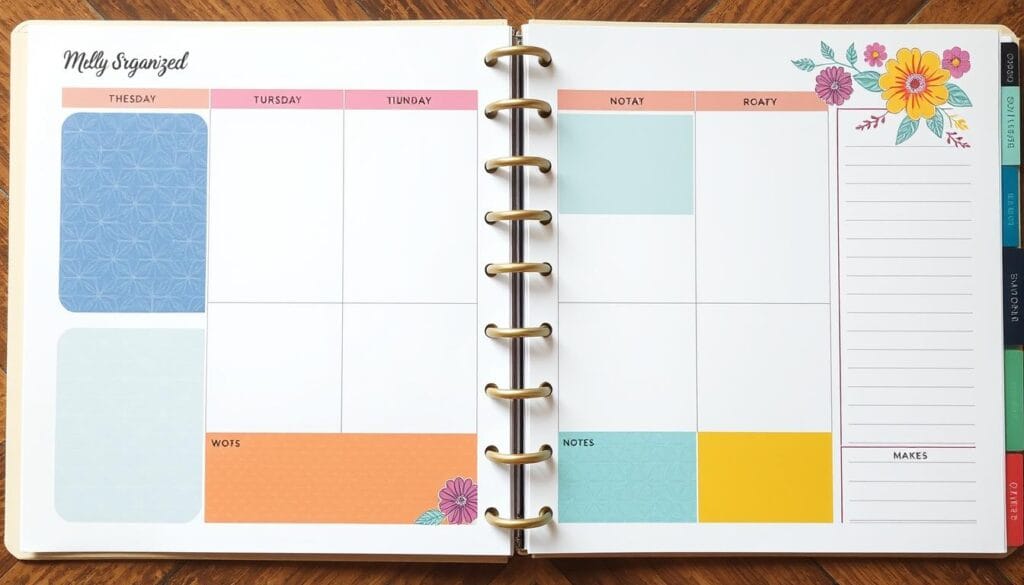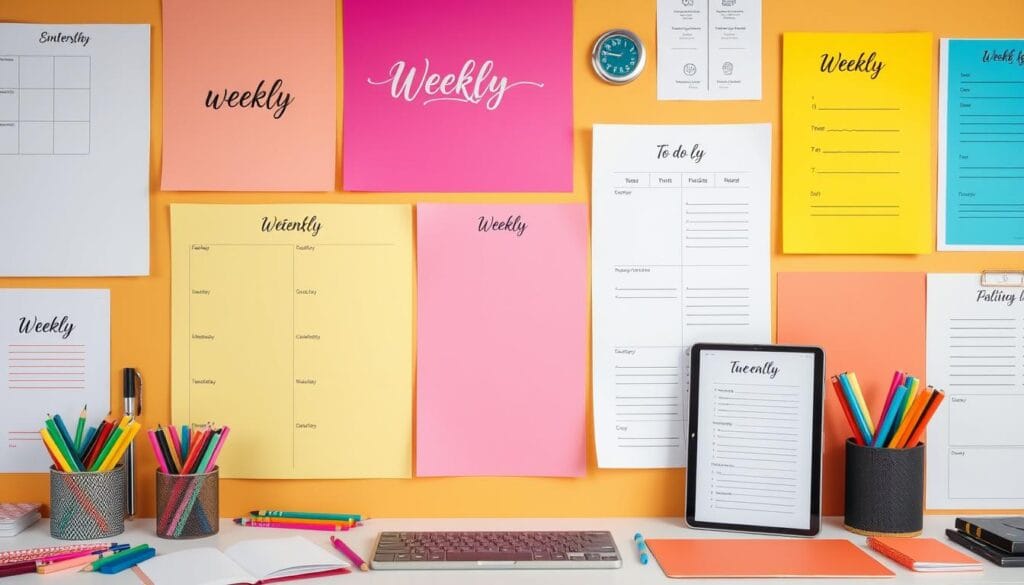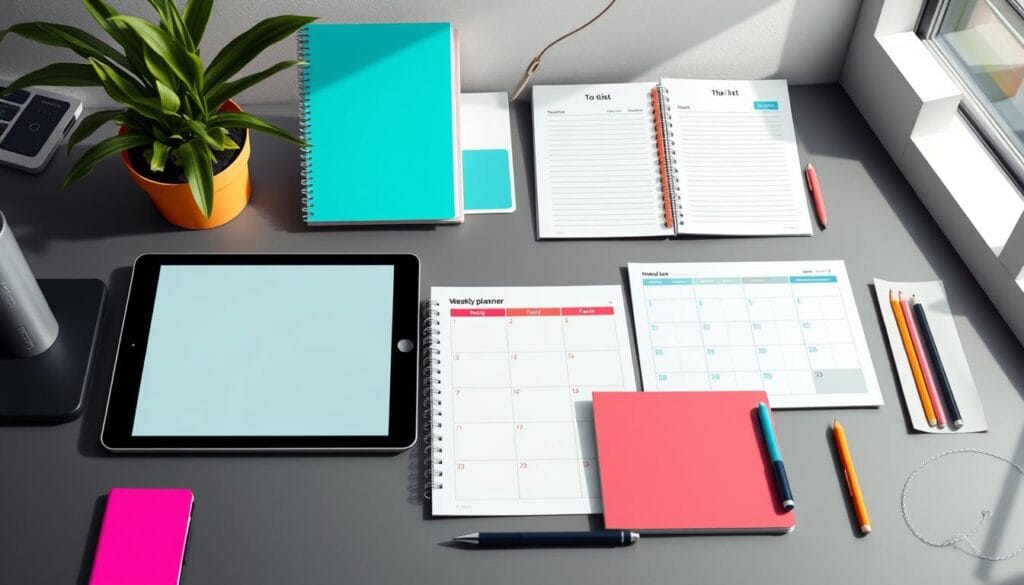I used to struggle with keeping everything organized. I had many notebooks, sticky notes, and planning systems that didn’t work. Then, I found digital files design, which changed everything.
Canva became my go-to for making weekly planners and to-do lists. It offers over 14,000 templates, making it easy to organize and be creative.
If you’re a freelancer, student, or professional, digital planning tools are for you. They help you track goals, manage tasks, and organize your day. Canva makes it easy to create planners that show off your style and needs.
Key Takeaways
- Discover the power of digital files design for personal organization
- Leverage Canva’s extensive template library for creating custom planners
- Explore graphic design techniques to make planning more engaging
- Transform traditional planning methods with digital tools
- Unlock creativity through visual communication strategies
Understanding the Power of Digital Planning Solutions
Digital planning has changed how we organize our lives. It uses UI/UX Design to offer flexibility and efficiency. This is more than what paper planners can do.
Benefits of Switching to Digital Planners
Switching to digital planning brings many benefits. It changes how you work:
- Instant access on any device
- Customization with Multimedia Design
- Interactive features for better engagement
- Quick search for information
- Cloud backup for safety
Key Features of Modern Digital Planning
Digital Art has made planning tools better. Today’s digital planners have cool features like:
- Clickable links in documents
- Real-time collaboration
- Productivity tracking
- Customizable templates
“Digital planning isn’t just about organization—it’s about creating a personalized system that adapts to your unique workflow.”
Why Choose Canva for Digital Planning
Canva is a top choice for digital planning. It has an easy-to-use interface for everyone. You can make professional digital planners without needing design skills.
For students, professionals, or creatives, digital planning offers flexibility and efficiency. It helps streamline your organization.
Getting Started with Canva’s Planner Templates
Starting your digital planning journey is easy with Canva’s vast Design Software library. You’ll find over 14,000 planner templates ready to change how you organize. It’s all right at your fingertips.
Exploring Canva’s template collection, you’ll see many options for every taste and style. The platform lets you customize a lot:
- Filter templates by specific needs (business, personal, academic)
- Adjust page numbers and design elements
- Select from daily, weekly, and monthly formats
- Explore niche-specific designs like fitness or budgeting planners
Pro tip: Templates marked with a crown symbol indicate premium Canva Pro subscription options, while uncrowned templates remain free to use.
Canva makes digital planning easy with its user-friendly interface. It offers features like:
- Hyperlink integration
- Clickable tabs
- Multimedia embedding options
- Extensive font combinations
Try Canva’s 30-day free trial to find the perfect template for you. It’s a great way to see what works best for your style.
| Planner Type | Customization Level | Availability |
|---|---|---|
| Daily Planner | High | Free & Premium |
| Weekly Planner | Medium | Free & Premium |
| Monthly Planner | High | Free & Premium |
Remember, the key to an exceptional digital planner is personalization. Canva empowers you to create a planning tool that truly speaks to your individual needs and aesthetic preferences.
Digital Files Design: Essential Tools and Features
Crafting digital files needs strong design tools to make your work easier. Web design and visual communication have changed a lot. Now, designers can make amazing digital planners and documents with ease.
Using design platforms can be tough, but tools like Canva make it simple. Knowing the right features can change how you create digital files.
Navigation and Interface Fundamentals
Canva’s design is made for easy use. It offers:
- Drag-and-drop functionality
- Intuitive menu structures
- Quick access to design elements
- Simplified toolbar navigation
Design Elements and Creative Assets
Good visual communication needs strong design assets. Canva has a huge library of resources:
- Thousands of free graphics
- Professional font collections
- Background templates
- Icons and illustrations
Template Customization Strategies
Customizing designs is important in web design. Canva lets you:
- Modify color schemes
- Adjust layout configurations
- Incorporate brand elements
- Create unique design identities
“Design is not just what it looks like and feels like. Design is how it works.” – Steve Jobs
Web design tools keep getting better. They help creators make professional digital files without needing a lot of technical skills.
Creating Weekly Planner Layouts in Canva
Digital Files Design in Canva lets you make your own weekly planners. These planners can boost your productivity. With Canva’s Graphic Design tools, you can design layouts that are both useful and beautiful.

- Date sections with clear navigation
- Customizable task lists
- Goal-setting areas
- Interactive elements
“A well-designed planner is the first step towards achieving your weekly goals.” – Productivity Expert
Canva’s grid system helps you line up your design parts perfectly. The drag-and-drop feature makes it easy to move things around. This ensures your layout looks great and is professional.
| Planner Layout Preference | User Percentage |
|---|---|
| Vertical, One-Page Layout | 65% |
| Horizontal, Two-Page Layout | 35% |
Pro tip: Start with a template from Canva’s library. Over 70% of users find it faster to begin with a pre-made template.
It takes 2 to 6 hours to make a digital planner. Focus on making it easy to use and add interactive features. This way, your planner will not only look good but also help you stay productive.
Designing Effective To-Do List Templates
Digital to-do lists have changed how we manage tasks. With 70% of people feeling overwhelmed, making a good template is key. It helps keep you productive and less stressed.
Making a strong to-do list template needs smart design. It should focus on how things look and feel. By using good organization, you can make a template that helps you get things done faster.
Task Organization Strategies
Managing tasks well is more than just listing them. Here are some important strategies:
- Break big tasks into smaller, easier ones
- Use colors or levels to show task importance
- Try time-blocking
- Start task descriptions with action verbs
Visual Hierarchy in List Design
Good design is key for a clear to-do list. Use design rules to guide the user’s eye:
- Change font sizes to show task importance
- Use different colors for task types
- Make sure there’s space between task groups
- Add icons for task types
Incorporating Productivity Elements
Add features that boost your productivity:
- Use progress trackers for big projects
- Track habits
- Set reminders for deadlines
- Make recurring tasks customizable
“A well-designed to-do list is not just about tracking tasks, but about creating a system that motivates and guides you towards achievement.” – Productivity Expert
By using these design tips, you can turn a simple list into a powerful tool. It will help you finish tasks faster and feel less stressed.
Customizing Colors and Typography for Your Digital Files

Making a unique digital planner means picking the right colors and fonts. Canva’s tools help turn your files into stunning, professional documents.
When building your brand, follow these typography tips:
- Stick to three typefaces
- Choose fonts that read well on all devices
- Use size to show importance
- Keep colors consistent
Colors affect how we feel about a design. Each color can make us feel something different, changing how we interact with it.
| Font Category | Brand Examples | Emotional Impression |
|---|---|---|
| Sans Serif | Google, Facebook | Modern, Clean |
| Serif | Time Magazine | Traditional, Elegant |
| Script | Coca-Cola | Personal, Distinctive |
“Typography is not just about selecting fonts, it’s about creating visual communication that resonates with your audience.” – Design Expert
Remember, typography is a 500-year-old art form with modern uses. Aim for a mix of colors and fonts that show off your brand and are easy to read.
Adding Interactive Elements and Graphics
Digital planners have changed a lot. Now, they are interactive and engaging. Canva’s UI/UX Design helps make them more interactive and inspiring.
Adding interactive parts can make users more engaged by up to 200%. Graphics and interactive features can make your digital planners better for users.
Selecting Appropriate Icons and Illustrations
When picking graphics for your digital planner, keep these tips in mind:
- Choose icons that clearly show what tasks they are for
- Use the same style for all illustrations
- Make sure graphics look good at any size and are high-quality
- Match the colors of your graphics with your design’s theme
Implementing Clickable Links
Clickable links make your digital planner interactive. You can link to other parts of the planner, external sites, or even scheduling tools.
“Interactive design is about creating experiences, not just interfaces.” – Steve Jobs
Enhanced User Experience Features
Make your digital planner more useful with these interactive features:
| Feature | Benefit |
|---|---|
| Fillable Form Fields | Allows direct data entry and tracking |
| Dropdown Menus | Organizes complex information efficiently |
| Hover Effects | Increases user interaction and engagement |
| Scroll Animations | Creates dynamic visual storytelling |
By using these multimedia design tips, you’ll make digital planners that are not only useful but also fun and easy to use.
Exporting and Sharing Your Digital Planners
After you finish designing your digital files in Canva, it’s time to export and share. The file format you choose is key to making sure your digital planners are easy to use.
Choosing the right export method makes your digital planner more accessible. Here are the top file formats for digital planners:
- PDF (Portable Document Format) – Best for print and digital sharing
- PNG – Ideal for image-based designs
- JPEG – Suitable for web and social media platforms
The PDF format is the most versatile for digital files design. It keeps high-quality images and stops others from editing, making it great for professional planners.
| Export Format | Best Use | Compatibility |
|---|---|---|
| Professional sharing | Universal | |
| PNG | High-quality graphics | Digital platforms |
| JPEG | Web sharing | Social media |
Sharing goes beyond just exporting files. Canva offers direct sharing options that let you:
- Send links to collaborators
- Publish online instantly
- Download for local storage
“Your digital planner’s potential lies not just in its design, but in how effectively you can share it.” – Digital Design Expert
Pro tip: Always check if your file works well with apps like GoodNotes. This ensures it works smoothly on different platforms.
Optimizing Your Designs for Different Devices
Digital planners need smart Web Design to work well on many platforms. With 84% of people having smartphones and mobile browsing over 60% of web traffic, making designs that adapt is key. This ensures UI/UX Design success.
To make digital files work on different devices, you must know some important strategies:
Mobile-Friendly Considerations
- Prioritize essential content for smaller screens
- Use responsive layout techniques
- Implement touch-friendly interface elements
- Minimize complex design components
Cross-Platform Compatibility
To make sure your digital planners work on various devices, plan carefully. Here are some important points to consider:
- Test designs on multiple screen sizes
- Use flexible grid systems
- Select scalable typography
- Optimize image and graphic rendering
File Format Best Practices
Picking the right file format is crucial for keeping your design looking good and working right. PDF is the top choice for universal compatibility, especially for interactive digital planners.
“Responsive design is not about fitting content into different screens, but delivering the right content at the right time.” – Unknown Design Expert
By using these strategies, you’ll make digital planners that offer great experiences on smartphones, tablets, and desktops.
Monetizing Your Digital Planner Designs
Turning your Digital Art into a profitable Brand Identity needs smart planning and creativity. Digital planners are a great way to make money online. You can sell them on marketplaces or your own site.
Top places to sell digital planners include:
- Etsy
- Gumroad
- Personal e-commerce websites
- Creative market platforms
How you price your planners is key to success. Here are some price ranges to consider:
| Planner Type | Price Range | Potential Monthly Earnings |
|---|---|---|
| Individual Digital Planner | $5 – $15 | $500 – $1,000 |
| Planner Bundle | $15 – $30 | $1,000 – $3,000 |
| Specialized Planner | $20 – $50 | $2,000 – $5,000 |
Your success with Digital Art depends on a few things:
- Unique design aesthetic
- Understanding your target market
- Staying active in marketing
- Providing a great customer experience
“Your digital planner is not just a product, it’s a solution to someone’s organizational needs.”
Use social media like Instagram and Pinterest to show off your Brand Identity. Use hashtags, join design groups, and share your work to get noticed.
Scalability is your biggest plus. Once you create digital planners, they can keep making money with little extra work.
Conclusion
Digital Files Design is a key way to organize and show information in today’s fast world. Tools like Canva help you make detailed weekly planners and to-do lists. These tools boost your productivity and make your work flow better.
Investing in good design is worth it. Forbes says you get a 9.9% return for every dollar spent on UX design.
Starting your journey in Visual Communication through digital planning opens many doors. Companies that focus on design grow twice as fast as those that don’t. Canva lets users make digital files that look great on any device.
The digital design process is more than making pretty templates. It’s about knowing what users need and using data to guide your work. You can keep things consistent while still being creative with your digital planning.
As you get better at digital file design, choose tools that are both beautiful and easy to use. Your digital planners can help you stay organized, productive, and even make money in the digital world.

